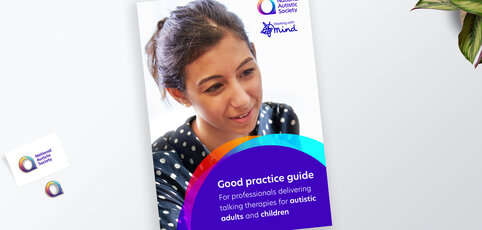OCD - a guide for professionals
A person diagnosed with OCD typically has intrusive thoughts, impulses and/or images that produce anxiety (ie obsessions), and repetitive behaviours that are carried out to reduce anxiety (ie compulsions). This guide explores more about the condition, similarities and differences between OCD and autism, and treatment options.
What is OCD?
“Obsessive compulsive disorder (OCD) has two main parts: obsessions and compulsions.
-
Obsessions are unwelcome thoughts, images, urges, worries or doubts that repeatedly appear in your mind. They can make you feel very anxious.
-
Compulsions are repetitive activities that you do to reduce the anxiety caused by the obsession. It could be something like repeatedly checking a door is locked, repeating a specific phrase in your head or checking how your body feels.” Mind
OCD can affect men, women and children and it usually starts during early adulthood.
Prevalence rate of OCD in autistic people
Research evidence is too limited to draw any accurate conclusions on how many people may have OCD.
Overlaps and differences between OCD and autism
Studies show there are overlaps between autism and OCD. Many behaviours are found in both:
- compulsive like behaviours
- restricted and repetitive behaviours
- fixation on routines
- ritualised patterns of behaviour
- resistance to change and restricted interests.
Some research suggests that whilst restricted and repetitive behaviours (RRBs) tend to develop similarly in both conditions, the role that anxiety plays in RRBs is a distinct difference between the two conditions.
In autistic people, RRBs such as stimming tend to reduce anxiety. In people with OCD, the repetitive behaviours can increase anxiety. To give an example, an autistic person or someone diagnosed with OCD may repeatedly flick a light switch on and off. The autistic person may be doing this because they like the sound of the switch and the visual feedback when the light flashes on and off. The person with OCD may be doing it because they believe that unless the light switch is flicked on and off 15 times, something bad will happen.
Autistic people suggest that obsessions and compulsions in OCD are an unwanted and intrusive element in a person’s life, whereas being autistic is a positive part of their identity.
Identification and assessment of OCD in autistic people
Assessment and identification of OCD in autistic people can be challenging. This may be due to a difficulty in separating the differences between the behaviours described in autism and the compulsions in OCD. There might be a risk of clinicians missing OCD in autistic people because the autism traits overshadow the OCD symptoms, or OCD symptoms are viewed as part of the autism spectrum.
Treatment for OCD
NICE guidelines on treatment for OCD
The National Institute for Health and Care Excellence (NICE guidelines (2016) recommend that for treating mental health conditions in autistic adults it is necessary to use interventions and medications “informed by existing NICE guidance for the specific disorder.” [Section 1.6.3] They also recommend how to adapt psychosocial interventions such as CBT for autistic people with coexisting mental health disorders.
Similarly, for children and young people, they recommend using psychosocial and pharmaceutical interventions “in line with NICE guidance for children and young people”. [Section 1.7.3] They also recommend how to adapt CBT for autistic children and young people.
Therapy
NICE recommends psychological treatment for OCD:
- cognitive behavioural therapy (CBT)
- exposure and response prevention (therapists encourage patients to tolerate anxieties without performing their compulsions).
Research shows that adapted CBT interventions can be useful for autistic people. Standard CBT should be adapted by:
- allowing more time for processing information
- using visual or written information
- parental involvement (where appropriate)
- self-monitoring (a technique in CBT)
- positive reinforcement
- using clear language and instructions.
Clinicians working at the South London and Maudsley NHS Foundation Trust (SLaM) have published a book on how to adapt CBT for autistic people with OCD - OCD and autism: a clinician’s guide to adapting CBT (2019) .
Medication
NICE recommends the use of the following medication for OCD for adults.
- Paroxetine
- Sertraline
- Citalopram
- Flouxetine
- Fluvoxamine
Inpatient treatment
Intensive inpatient treatment in hospital may be required for those with significantly intrusive thoughts and compulsions.
Charities offering OCD advice
Other than the guidelines outlined by NICE, there is no specific advice about supporting or treating autistic people with OCD, but there are several charities that offer general help and information, such as OCD Action, OCD UK and Mind.
Useful resources
Books
-
Russell, Jassi and Johnston (2019) OCD and autism: a clinician’s guide to adapting CBT.
Personal accounts
The following accounts may share information and experiences that you may find distressing.







